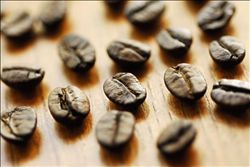Roasting degree of coffee beans Coffee roasting technology Italian coffee machine extraction leakage
Baking involves a series of chemical changes. After roasting for about 5-25 minutes (depending on the temperature chosen), the green beans lose some moisture and turn yellow. During this process, coffee beans expand, transforming from a firm, high-density green state to a low-density, fluffy state. During this process, the beans roughly double in size and begin to take on a light brown color after being lightly fried. After this stage is complete (approximately 8 minutes of baking), the heat will decrease. The color of coffee quickly changes to dark. When the preset roasting depth is reached, cold air can be used to cool the coffee beans to stop the roasting process.
Baking is generally divided into Light Baking, Medium Baking, City Baking and Deep Baking. Light Roast Coffee Beans: May have a strong smell, crispness, high acidity as the main flavor and slight body. Medium-roasted coffee beans: have a strong alcohol, but also retain a certain acidity. City-roasted coffee beans: dark brown on the surface, acidity replaced by a slightly burnt bitterness, flavor mostly destroyed. Deep Roast Coffee Beans: Dark brown in color, oily on the surface. For most coffee beans, alcohol is significantly increased and acidity is reduced. Roasted coffee is actually a way of processing food. Professional coffee roasting is a personal expression of the roaster. Just getting started with specialty coffee
Coffee beans of different roasting degrees
Coffee beans of different roasting degrees
(SPCIAITYCOFFEE) The biggest trouble is the name of the baking degree. For example, CITY, FULLCITY, FRENCH, ESPRESSO, etc. are all different because of the different baking machines used and the different production areas, and produce different baking degrees of color. In addition, some roast degrees are named after blends: ESPRESSO, for example, is a blend of coffees with a specific roast degree used to make ESPRESSO, which may have completely different flavors even if the color looks the same. So the choice of bean type, baking temperature and baking method, baking time are the main factors to determine the final flavor

Important Notice :
前街咖啡 FrontStreet Coffee has moved to new addredd:
FrontStreet Coffee Address: 315,Donghua East Road,GuangZhou
Tel:020 38364473
- Prev

Coffee beans-production tips and production methods
1. In order to avoid bitterness, never boil coffee. The ideal temperature should be between 90 ℃ and 96 ℃. two。 Don't heat the coffee again. It is recommended to determine how much to make according to the amount of drinking each time, and make sure you get fresh coffee every time. The temperature to maintain the best flavor of coffee is 86 ℃. 3. Use fresh, cold water to make. The water content of each cup of coffee is 98%. If the water
- Next

What is the difference between coffee and coffee beans?
In fact, the word robert comes from the most widely grown variety of carnivora coffee. Robbett is a very strong shrub or small tree, more than 10 meters tall, but its roots are shallow. The fruit is round and matures for 11 months. The seeds are oval and smaller than arabica beans. in Midwest Africa, all of Southeast Asia, and in a region of Brazil called Conilon.
Related
- Does Rose Summer choose Blue, Green or Red? Detailed explanation of Rose Summer Coffee plots and Classification in Panamanian Jade Manor
- What is the difference between the origin, producing area, processing plant, cooperative and manor of coffee beans?
- How fine does the espresso powder fit? how to grind the espresso?
- Sca coffee roasting degree color card coffee roasting degree 8 roasting color values what do you mean?
- The practice of lattes: how to make lattes at home
- Introduction to Indonesian Fine Coffee beans-- Java Coffee producing area of Indonesian Arabica Coffee
- How much will the flavor of light and medium roasted rose summer be expressed? What baking level is rose summer suitable for?
- Introduction to the characteristics of washing, sun-drying or wet-planing coffee commonly used in Mantenin, Indonesia
- Price characteristics of Arabica Coffee Bean Starbucks introduction to Manning Coffee Bean Taste producing area Variety Manor
- What is the authentic Yega flavor? What are the flavor characteristics of the really excellent Yejasuffi coffee beans?

